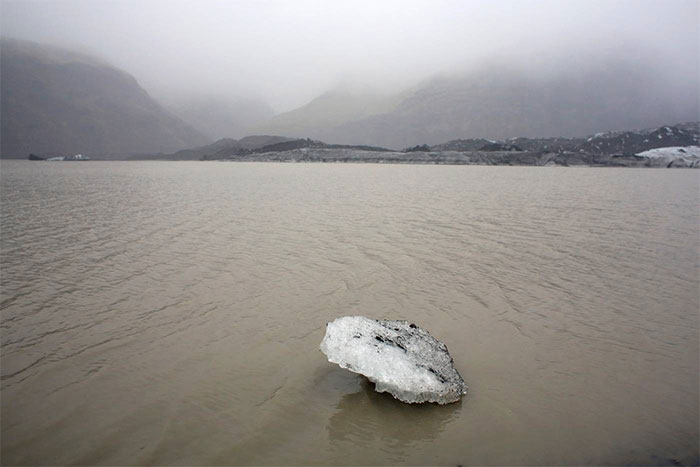When the glaciers in Iceland melt into small streams
The thickness of the ice on the Solheimajokull River between these two snow-covered year-round mountains has decreased by 40m per year for the past 10 years.
Lilja Einarsdottir, an Icelandic 7th-grader enthusiastically participated in extracurricular activities with classmates to measure the thickness of the ice on the Solheimajokull River .
For her and her classmates, this activity is not just a natural experience but also an opportunity for future citizens of this icy year-round land to directly feel the impact of change. The climate in the first place on Earth to witness the unpredictable consequences of the phenomenon is a global concern.

Iceberg on the lake in front of the Solheimajokull Glacier, Iceland.(Photo: AFP / TTXVN).
This is the ninth year of extracurricular activities conducted each October, according to the idea of teacher Jon Stefansson bringing groups of 13-year-old students at a school in the village of Hvolsvollur to this glacier to verify the change. over the years.
Their measurements show that the thickness of the ice on the river between these two snow-covered year-round mountain ranges has decreased by 40m per year over the past 10 years.
Solheimajokull Glacier is a famous tourist destination of Iceland that welcomed 27,000 tourists in 2018. This glacier belongs to the Myrdalsjokull glacier , the fourth largest in Iceland.
Beneath the ice is the strongest Katla crater in Iceland, always "waiting" for an opportunity to erupt again after sleeping peacefully since 1901.
According to the manual measurement of student groups, in the last 10 years, the ice layer of about 380m thick has disappeared. In particular, in 2018 alone, the thickness of the ice on this river decreased by 110m, in 2019 it was 11m.
It may not be accurate yet, but these are also figures that show worrisome and increasingly serious changes in the region. Official figures from the Geological Society of Iceland show that the thickness of the ice at Solheimajokull decreased by 200m in 2018.
The melting process can even be observed with the naked eye as water drips from the ice sheets and sometimes flows into small streams.
Glaciers once covered about 11% of Iceland's surface area, including the Vatnajokull glacier, Europe's largest ice cap. But in the past 25 years, about 250km3 of ice has melted, which is equivalent to 7% of the region's total volume of ice.
Glacial researcher Hrafnhildur Hannesdottir of the Iceland Hydrometeorology Agency says more and more lakes are forming in succession on the glaciers.
Last August, Iceland made a memorial to the Okjokull Glacier, the first glacier confirmed to disappear completely in 2014. This stele serves as a reminder of the impact of climate change. climate in the context of scientists' concern that under the impact of climate change more than 400 glaciers on the island of Iceland could disappear completely by 2200.
- See the mesmerizing beauty of Iceland nature
- Find the main culprit causing the glaciers to melt
- Video: Beautiful Iceland under the view of Drones
- 20% of Canadian glaciers disappeared in this century
- Want to see the sun all day without diving, go to Iceland!
- The world's most dangerous glacier is about to melt, catastrophic with Earth?
- Unbelievable facts about Iceland
- Melting glaciers make the food crisis
- Melted glacier water subsides the ocean floor
- Glaciers in Asia are unusually bloated
- The Andes glaciers narrowed the record
- Warning of glaciers in Peru is likely to disappear
 Is the magnetic North Pole shift dangerous to humanity?
Is the magnetic North Pole shift dangerous to humanity? Washington legalizes the recycling of human bodies into fertilizer
Washington legalizes the recycling of human bodies into fertilizer Lightning stone - the mysterious guest
Lightning stone - the mysterious guest Stunned by the mysterious sunset, strange appearance
Stunned by the mysterious sunset, strange appearance